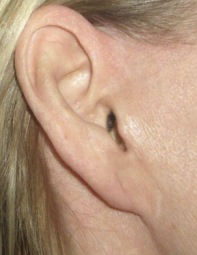
A variety of surgical techniques have been used to correct the pixie earlobe deformities. These include a V-Y release and elevation of the earlobe and redoing a portion of the facelift to get the skin to sit up higher under the earlobe. The V-Y release, although very effective, results in visible scars below the earlobes. Re-doing a portion ofmthe facelift is unappealing given the extent of the procedure.
In the Online First edition of the July 2015 issue of Annals of Plastic Surgery, a case report was published entitled ‘A Novel Method for Correction of the Hypoplastic Pixie Earlobe Deformity: V-Y Advancement Flap and Dermofat Graft’. The authors describe a novel technique method for the correction of pixie ear deformity in patients with small ear lobules. Rather than re-doing the facelift and tucking it up under the earlobe, the reverse approach was used. The small earlobe was expanded by a V-Y advancement skin flap on the back of the earlobe. A dermal-fat graft was inserted under the skin of the advanced flap to prevent retraction. In essence the pixie ear lobe deformity was camouflaged by making the earlobe longer. This is done while making no scars on the front or the bottom of the earlobe. This allows for a natural appearance of the earlobe to be attained.
While the pixie earlobe deformity after a facelift can be treated by numerous methods, the small earlobe presents the opportunity to use a reverse approach from the traditional re-rotation of the facelift skin flaps. It is inherently more stable to bring the earlobe down than it is to pull the skin on the sides of the face up.
Dr. Barry Eppley
Indianapolis, Indiana


